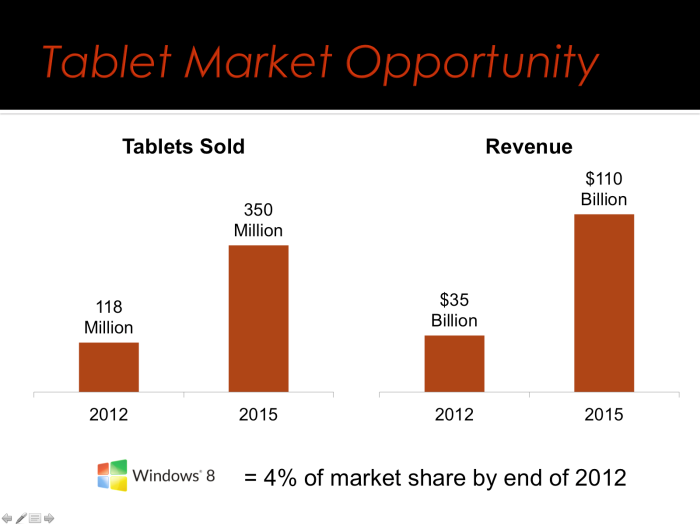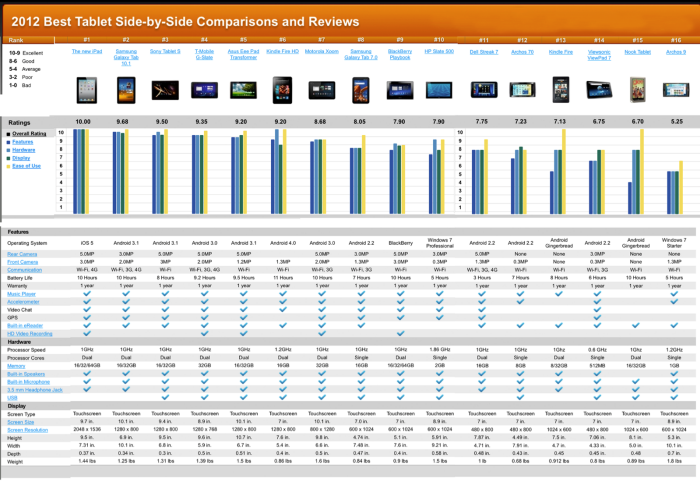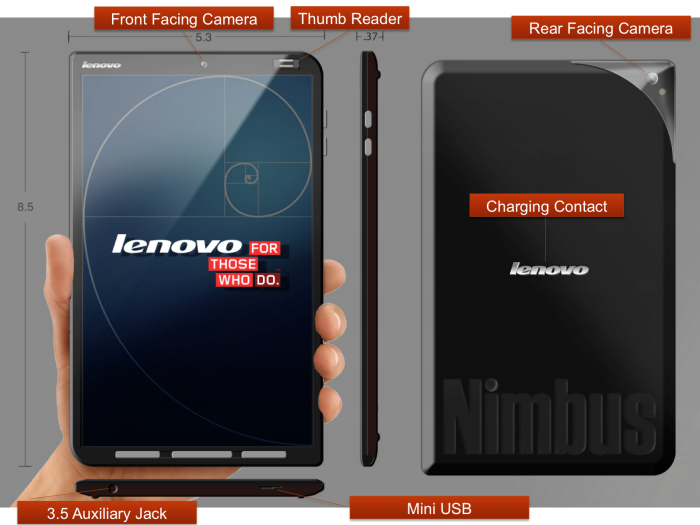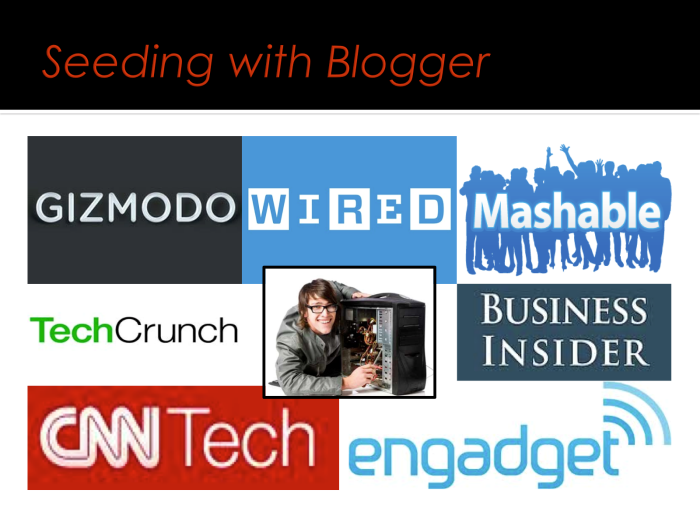






Where we aimed our solution to reside

The first and most significant issue is the perception that tablets do not permit for the same amount of productivity as laptops or desktop computers. Respondents believed this was largely due to not having an independent mouse and full keyboard.

After performing our Voice of Customer it became clear there were two main segments we wanted to design for: 1) the working professional and 2) small business owners. Additionally, as we started to outline our marketing ideas a third segment, the technology aficionado, was added. Though we would not be designing for the technical needs of this segment as they differ largely from the other two groups, we would need to be able to peak their interest as their feedback and reviews would be important in marketing efforts when it was time to launch the product.
We felt like the best way to capture the information we collected was to create personas. By creating these personas, our target segments became people we could easily design against, instead of simply numbers and quotes on in the research. All of our product and design decisions were tested against one or more of the final three personas.


Michelle’s Computing Life
Computing Needs:
• Portability with long battery life
• Microsoft Office compatibility
• Note writing functionality
• Connection to peripherals such as keyboard, mouse, printer, camera, smartphone, headphones and vehicle telematics systems
• Easy home-on the road-in the office transitions
• Portable keyboard and mouse that will allow for increased productivity
• Storage
• Cloud Computing and remote server access
• Rapid boot up
• Easy access to travel items and preferences (boarding passes and itineraries)
Number #1 Hurdle: Will a tablet allow me to be as productive as a laptop?


Susan’s Computing Life
Computing Needs:
• Portability but durability
• Microsoft Office compatibility
• Easy home-on the road-in the office transitions
• Inventory management system
• Ability to accept credit card payments
• Ability to receive signatures
• Easy to use out of the box
• A server or secure cloud space to store documents on to access remotely
Number #1 Hurdle: Price


Adam’s Computing Life
Computing Needs:
• Portability but durability
• Microsoft Office compatibility
• Easy home-on the road-in the office transitions
• Processing power
• Easy home-on the road-in the office transitions
• Cutting edge technology
Number #1 Hurdle: Is it powerful enough? Is it cool enough?

Customer needs for the 3 personas our team created using extensive customer feedback

The ecosystem is made up of three parts. It is focused on hardware with services for those consumers to build a community of loyal customers.




The main component of Hardware is the Lenovo Nimbus tablet





ThinkPad Nimbus
Our vision starts with the brain of our family of products, the Lenovo ThinkPad Nimbus. ThinkPad Nimbus is a highly portable, 9” (16:10 ratio display), Windows 8 Pro tablet designed to be as functional as it is light and beautiful.
Designed to be the center of the computing universe, ThinkPad Nimbus serves as the user’s gateway to information whether it comes from wired or cloud-based networks at the office, home, and everywhere in between.
ThinkPad Nimbus offers industry-leading processing power, storage, connectivity, and multimedia options in an ergonomic package, designed for high-mobility.


Nimbus Features
Tablet Prospective
Rear Camera / 4800x2700 (13 Megapixel) / $6.20
Front Camera / 4800x2700 (13 Megapixel) / $6.20
Battery Life / 10Hrs/11500mAh / $32
Accelerometer / $15
Display :
Screen Type / Touch Screen
Screen Size / 9.7 (10in)
Screen Resolution / 2048x1536, >267ppi / $127 ($387 Total)



Front Facing Camera, Lenovo Thumb Reader - for secure and fast log in, 3.5 Auxiliary Jack - for headphones, Mini USB3 Port, Rear Facing Camera and Flash- with non scratch lens that does not collect lint, Lenovo Emblem Charing Contact on back for quick charging and not having to plug it in.

The primary branding element is the Nimbus logo. It will use the same typeset as ThinkPad and will have the signature red dot over the “I.” This is also true of the logos for the Terminal, Terrain and Transit. The slogan for the Lenovo ThnkPad Nimbus System will allow 1) an explanation of the consumer benefits of the system while 2) further tying the product to the Lenovo by using the word “Do” in the same visual context it is used in the Lenovo slogan. Lastly, to ensure the Nimbus line is identified with the Lenovo brand, the Lenovo logo and slogan will be used in marketing efforts.

After creating study models for the tablet, our team realized customers were still concerned about reduced productivity using only a virtual keyboard on the tablet screen. For applications with a productivity focus, users appeared to be unwilling to migrate off the traditional keyboard and mouse peripherals onto the touch screen UI. Some of express needs that were specified were:

Features: Full size keyboard, Multi-function trackpad --
Many business professionals need a way to optimize productivity as they travel for work. The Transit isn’t an average keyboard folio. Transit provides a full-sized Bluetooth 4.0 chicklet keyboard over a multi-touch trackpad featuring high-sensitivity touch detection, allowing it to double as a writing surface for sketches and note dictation, signatures. The track-pad functions with the ability to assign different areas as different functions, for example on the right hand side using it as a numerical keypad . Then there is an overlay of a keyboard attachment which is just the frame and keys, so there is no redundant batteries, electronics, or hardware. The keyboard simply provides tactile feedback to the user and transfers the force of the buttons to the track-pad in keyboard mode. Which will identify which area is being pressed and assign that character to show up as being typed.


The Lenovo Terminal is a tablet dock that allows the ThinkPad Nimbus to quickly “plug-in” to host environments through an ultra-wide band (UWB) receiver that communicates with the dock. The Terminal maintains a wired connection to all wired peripherals and desktop monitor. The Dock also keeps the tablet upright to allow multi-display setups using the ThinkPad Nimbus.
Additional features include:
• Auto-connect/Auto-Startup to tablet within 5ft
• Passive tablet cooling design
• Automatic peripheral stand-by mode
The Terminal will enable the user to have greater flexibility when navigating between environments. The unit will be inexpensive enough to allow users to have multiple Terminals – one for their home and office with a specially designed Terminal for vehicles.

For customers looking for a tablet computer that supports the on-the-feet nature of their work, the Terrain is an ergonomic grip accessory designed specifically to make ThinkPad Nimbus comfortable to hold over long periods of time, in both landscape and portrait positions. Terrain offers a built in micro USB 3.0 to USB 3.0 adapter. This USB 3.0 port can be used to attach an optional credit card reader accessory for retailer customer point of sale applications. Those needing additional battery life can opt for the Terrain XL, which adds an additional 10 hours of battery life to the ThinkPad Nimbus.


Lenovo Select - Business Professionals
To support the unique needs of business professionals Lenovo could offer the following services as part of a service package called Lenovo Select.
Need-based Mobile Data.
Lenovo could work with the telecoms to secure wholesale quantities of data to provide customers on a need basis to save them from purchasing quantities of data they may never use. The data could be sold at discount as a result of wholesale savings or included as part of a larger service.
Airport Productivity Suites
Similar to the airlines that offer airport lounges to premiere customers, Lenovo could sponsor quiet, comfortable working spaces in major metropolitan airports where customers have access to Lenovo frames, and wifi.
Hardware Loaner Service
Lenovo could offer a service where, within 12-24 hours, they could ship a loaner
device to the traveling professional wherever they are to allow them to remain productive until they get back to the office for a replacement from IT.

Lenovo “Pro-File”
At the heart of all successful ecosystems is a centralized customer identity. Software giants such as Google, Microsoft, and Apple all offer their customers an account profile that enables their users to enter personal information and identifying characteristics once and use it across multiple software products. Lenovo could benefit their customers from a similar perspective when it comes to hardware. We propose a Lenovo “Pro-File”, a cross-system customer identity that allows users to collate personal data, hardware setting preferences, a secure account wallet (ex. Google, Apple ID, Microsoft, Facebook, LinkedIn log-in data all in one place), a master calendar and contact list regardless of the location of the user or the cloud accessed (work/home/travel). This would allow users to access and maintain access to some of the most useful information even when disconnected from their work/home servers.

Lenovo Select - Business Professionals
To support the unique needs of business professionals Lenovo could offer the following services as part of a service package called Lenovo Select.
Need-based Mobile Data.
Lenovo could work with the telecoms to secure wholesale quantities of data to provide customers on a need basis to save them from purchasing quantities of data they may never use. The data could be sold at discount as a result of wholesale savings or included as part of a larger service.
Airport Productivity Suites
Similar to the airlines that offer airport lounges to premiere customers, Lenovo could sponsor quiet, comfortable working spaces in major metropolitan airports where customers have access to Lenovo frames, and wifi.
Hardware Loaner Service
Lenovo could offer a service where, within 12-24 hours, they could ship a loaner
device to the traveling professional wherever they are to allow them to remain productive until they get back to the office for a replacement from IT.

To support the unique needs of small business owners Lenovo could offer the following services as part of a service package called Lenovo Connect.
Virtual Server Lease Service
Few small businesses have the interest or capital to invest in a full-fledged IT department. Many would prefer a turn-key solution where they can lease the hardware and necessary support from a single service. Lenovo could offer a virtual server lease solution and data storage where all the processing is done remotely on Lenovo servers. Lenovo tablets could be used as input and display devices controlling the server activity. This would save small business owners the need to purchase and troubleshoot hardware.
Lenovo Shifu (Shee-Foo aka Master)
The Lenovo Shifu would be an in-house mobile hardware expert that travels to small businesses to troubleshoot, answer questions, and provide recommendations on other Lenovo products.


Understanding how to build a community within the ecosystem is as important as bringing in new customers.


New Customer-Focused Lenovo Website
The Lenovo Community Forum would be an interactive web-destination for Lenovo customers and enthusiasts to learn about and discuss Lenovo products and accessories. Users will find helpful product video tutorials and have the opportunity to ask Lenovo “Shifus” specific questions to troubleshoot or simply get to know their devices. Lenovo customers can interact with other customers and provide tips, tricks and recommendations. Lenovo could use this site to crowd-source product ideas and select candidates to participate in concept feedback sessions. Lenovo could also use this website to launch a Lenovo Personalization Shop where 3rd party customization offerings and accessories are sold.

Customer Loyalty Program
Lenovo would develop a loyalty program to promote customer retention. A successive number of Lenovo product purchases could earn a customer discounts towards hardware, services, complimentary app store credit, or early access to new products before the regional release dates.
Developer Hardware Program
Lenovo would offer free or discounted hardware to application developers in exchange for added functionality or discounts on applications for Lenovo customers.

Core positioning and brand strategy
The core position for the Lenovo ThinkPad Nimbus will be consistent across all target markets as being able to get things done in different environment is central to all. Additionally, it is important to stay within Lenovo’s current brand identity.
The core positioning will be focused on leveraging Lenovo’s brand positioning as a brand that allows people to be productive at their jobs and marrying that with the portability a tablet provides.

Continuation of Current Lenovo Outlets
Because part of the evolution of the ThinkPad Nimbus system includes the planned cannibalization of Lenovo laptop products, it is important to make that transition as easy for customers as possible. This begins by having the ThinkPad Nimbus system available in Lenovo’s current retail outlets.
New Outlets
In addition to existing outlets additional outlets would be added that currently sell the ThinkPad Nimbus system’s main competitors: iPad, Microsoft Surface or the Samsung Galaxy Tablet or Note 10.1. By adding these outlets, the ThinkPad Nimbus system will be available when a customer is trying to make a purchase decision at the store when they are selecting a tablet.



Market Entry and Positioning Strategy
The launch strategy for the Lenovo ThinkPad Nimbus will be a full-scale national launch. This approach is customary in the consumer electronics industry and there is no evidence that it will not work in the case of the launch of the ThinkPad Nimbus.
Target Markets
The launch strategy for the Lenovo ThinkPad Nimbus will focus on two target markets with an eye toward a third.
The primary target market will be business professionals. Within this market there will be a leaning toward the sub segment that has occupations that require them to spend time working away from their desk. This could mean they spend a large amount of time in meetings, in the field, in airports or working from home.




Tech Blogosphere
As the market continues to transition as a result of consumerization, Lenovo should continue to embrace the tech blogosphere. Engadget, The Verge, CNET, Gizmodo, BGR and others have the opportunity to set expectations of new products based on their reviews. Lenovo should work to make the most of these information channels by releasing items for review, making executives and hardware designers available for interviews, and inviting these members of the press to high profile launches that will allow bloggers to build buzz in the online community.



Lenovo Studios
The Lenovo Studio would be Lenovo’s business-minded version of a flagship store. Office and small business environment models would help customers see how Lenovo products can allow productivity in all environments. Lenovo would use this center to test new concepts and hardware. There would also be a Lenovo Productivity Suite on site to allow traveling business professionals a space to be productive and have access to Lenovo’s line of hardware and accessories. All of the production items displayed would be available for immediate sale or shipped to another location.


Key Assumptions
• Periods are done in 6th month increments. Given the rapid change in technological progress the team felt this would reflect t the most likely scenario for the Lenovo ThinkPad Nimbus.
• Manufacturing and production costs are estimated to go down by an average of 5% each year.
• 20% Profit Margin on ThinkPad Nimbus
• Yearly Changes:
-20% in Sales/Period
-10% Marketing Expense
-40% Price drop after 2.5 years
-5% in manufacturing costs
• Financial analysis assumes obsolescence at 2.5 years. Obsolescence is understood to mean that an upgraded product is available and it has reached the end of its product life cycle. This does not necessarily refer to the end of support or degradation in performance of the product.
• All production for tablet and tablet dock are sub-contracted. costs reflect this production method.
• Marketing costs were derived by observing the "Selling and Distribution Expense" item on the Consolidated Income Statement of Lenovo's 10-K Annual Report

After 6 Periods with an NPV of 3.5%63, we expect profits of $10.5 Billion US Dollars at 10% market share.


Strategic Partnerships
Lenovo has an opportunity to build corporate partnerships to help reinforce the ecosystem through complementary goods, services, and brand power.
A useful partnership would be with 3rd party accessory manufacturers such as Belkin, Incase, B&O, and Jawbone to make the product extensions that Lenovo sees low value in pursuing. If Lenovo would provide product specifications to these manufacturers prior to launch, this would give these 3rd parties an opportunity to have accessories ready at the same time.
Lenovo should work to expand their working relationships with the wireless telecoms. Lenovo could work out an arrangement to buy large quantities of 3g and 4g wireless data at wholesale prices and resell it to customers at small margin or make it part of a larger service package.

gLike



















